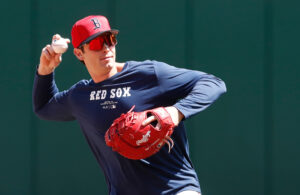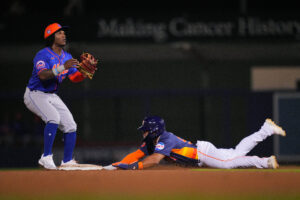A baseball glove has fingers. A mitt doesn’t. By rule only catchers and first basemen are permitted to wear a mitt, while all other players must wear a glove. According to the Baseball Rules Academy, a first baseman’s mitt may be no longer than thirteen inches. It can also be no wider than eight inches and have a webbing no longer than five inches. And if an umpire deems that a defensive shift positions a first baseman too far away from that position, that player can be ordered to ditch the mitt and change to a conventional glove. In short, the first baseman’s mitt is very different by design and for real reasons.
Uncertain Origins
No one really seems to know when the first baseman’s mitt came into being. Photo evidence shows them in use more than a hundred years ago, but not universally. According to one-time Kansas City Royals farmhand, and now custom baseball glove maker Pete Vinci, the first baseman’s mitt became all the rage in the 1940’s. That’s when most rules regarding the mitts came into being as well. “Over the years the first baseman’s mitt has gotten bigger,” Vinci said. “Forty years ago they were 10.75 or 11 inches in length. Now, 13 inches…even 13.5.” Here’s to hoping umpires don’t carry tape measurers as standard equipment.
Modern Players’ Preferences
Austin Byler is a former Arizona Diamondbacks minor league first baseman and a managing partner of Major League University in Arizona. “I used the Wilson A2000. It always felt good on my hand and that’s the key.” That’s what Byler wanted in his mitt and what he advises the players he coaches to seek in theirs. “Your mitt really becomes a part of you on the field,” Byler said. “Especially at first base, you take more throws than any player but the catcher. You can’t have the distraction of an uncomfortable or unwieldy mitt.” Good advice for young baseball and softball players.
Genesis of the Mitt
Over the years the first baseman’s mitt has taken shape in a functional way. The curved edge on the long side of the mitt helps with scooping not by its shape, but by providing a more uniform unit. A glove’s fingers shift individually which can make for instability when taking throws at awkward angles. Vinci adds, “Especially on backhand catches and scoops. Having the mitt move as one piece makes it easier to gain control of the ball.” The pocket on a first baseman’s mitt forms a V-shape designed to funnel the ball into the webbing. Construction of the webbing often consists of solid strips spanning the length and breadth of the gap between the index finger and thumb. One vertical strip is a single post and two a double post.
Vinci says a near-forgotten web design has made a recent resurgence. “The Net-T has made a real comeback in the past ten years. You almost never saw it for years and years. Now everyone wants one.” The Net-T web consists of a solid piece of leather in a t-shape that attaches at the top of both sides of the web gap and at the middle of the bottom edge. The “net” is formed by intertwining leather laces through the gaps on both sides of the t-shape.
Maintenance
There are literally dozens of ways to break in and maintain mitts and gloves. But the first baseman’s mitt again differs from the rest. Byler describes a kind of “Goldilocks Zone” he worked his mitts into. “I wanted the mitt to be soft enough to move however I wanted it to, but stiff enough to support my hand catching hard hit and thrown balls.” To condition his mitts Byler chose an unconventional means. “I usually just spit in them. Just spit in it a lot and rub it in to keep the leather moist and moveable.” That’s a means of conditioning that made Vinci cringe. “Oh God no!,” he shrieked. “The saliva has acids in it that are bad for the leather.” The veteran glove maker recommended petroleum jelly to soften and preserve glove leather.
Today Versus Yesteryear
According to Vinci gloves and mitts of today stack up better than old school models. “People think that the leather years ago was better, but it’s actually not.” His reasoning makes a great deal of sense. “It’s the tanning process that has changed. Back then they used a lot of chemicals that are banned now. The leather today is actually higher quality.” Both experts agree that superior materials and more refined design make today’s first basemen mitts better than those from times past.
Seeing With Different Eyes
The first baseman’s mitt is something we as fans all recognize but seldom look at with a critical eye. Its design goes beyond just tradition with practicality in mind and is defined by rules of the game. The first baseman is the only player on the field encouraged to catch the ball one-handed. That mitt is constructed just for it. Other mitts and gloves are made to accommodate one-handed grabs, but two-handed usage is always encouraged. So the next time you take in a ball game, watch the first baseman for a while. Take note of how the mitt is used differently at that position and enjoy a deeper appreciation for the game.
Main Photo: Embed from Getty Imageswindow.gie=window.gie||function(c){(gie.q=gie.q||[]).push(c)};gie(function(){gie.widgets.load({id:’2MqO2dbOTt9iEMm6vTdyYQ’,sig:’iDmYwfoNA4BXLezbweb5RhhNbzF-4AEV2itBX1ArySI=’,w:’594px’,h:’396px’,items:’521584130′,caption: true ,tld:’com’,is360: false })});






